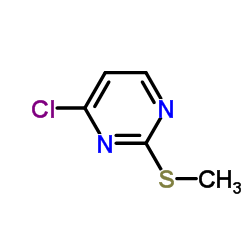2-methylthio-4-chloropyrimidine

2-methylthio-4-chloropyrimidine structure
|
Common Name | 2-methylthio-4-chloropyrimidine | ||
|---|---|---|---|---|
| CAS Number | 49844-90-8 | Molecular Weight | 160.625 | |
| Density | 1.4±0.1 g/cm3 | Boiling Point | 243.1±13.0 °C at 760 mmHg | |
| Molecular Formula | C5H5ClN2S | Melting Point | −2 °C(lit.) | |
| MSDS | USA | Flash Point | 100.8±19.8 °C | |
| Symbol |

GHS05 |
Signal Word | Danger | |
|
Concise total syntheses of variolin B and deoxyvariolin B.
J. Org. Chem. 70(16) , 6204-12, (2005) The total synthesis of the marine alkaloid variolin B has been achieved in 8 steps and 17% overall yield, starting from commercially available 4-chloro-2-methylthiopyrimidine. The key reaction involves the tandem deoxygenation and cyclization of a triarylmeth... |
|
|
Design, synthesis, and activity of 2-imidazol-1-ylpyrimidine derived inducible nitric oxide synthase dimerization inhibitors.
J. Med. Chem. 50 , 1146, (2007) By the screening of a combinatorial library for inhibitors of nitric oxide (NO) formation by the inducible isoform of nitric oxide synthase (iNOS) using a whole-cell assay, 2-(imidazol-1-yl)pyrimidines were identified. Compounds were found to inhibit the dime... |
|
|
Novel vanilloid receptor-1 antagonists: 1. Conformationally restricted analogues of trans-cinnamides.
J. Med. Chem. 50 , 3497, (2007) The vanilloid receptor-1 (VR1 or TRPV1) is a member of the transient receptor potential (TRP) family of ion channels and plays a role as an integrator of multiple pain-producing stimuli. From a high-throughput screening assay, measuring calcium uptake in TRPV... |
|
|
2,4-disubstituted pyrimidines: a novel class of KDR kinase inhibitors.
Bioorg. Med. Chem. Lett. 13(10) , 1673-7, (2003) 2,4-Disubstituted pyrimidines were synthesized as a novel class of KDR kinase inhibitors. Evaluation of the SAR of the screening lead compound 1 (KDR IC(50)=105 nM, Cell IC(50)=8% inhibition at 500 nM) led to the potent 3,5-dimethylaniline derivative 2d (KDR ... |
|
|
Pyrimidines. XIII. 2-and 6-substituted 4-pyrimidinecarboxylic acids. Daves GD, et al.
J. Heterocycl. Chem. 1(3) , 130-133, (1964)
|